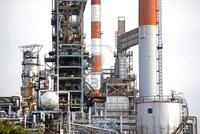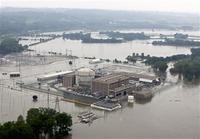-
Malware imported into U.S. on foreign-made components

A high level DHS official acknowledged that malware built into imported electronic components sold in the United States poses a serious threat to U.S. economy and security; he also said it was a complex threat which the federal government has been trying to address in different ways; Greg Schaffer, acting deputy undersecretary for the National Protection and Programs Directorate at DHS, said the threat is “one of the most complicated and difficult challenges we have”
-
-
Securing critical infrastructure: portfolio based approach
Bryan Ware, the CEO and co-founder of Digital Sandbox, a firm that provides risk analysis and management software and services to the private and public sectors, was recently interviewed by Homeland Security NewsWire’s executive editor Eugene Chow; Ware discusses a portfolio based approach to securing critical infrastructure, what the government can do better to protect critical assets, and the dangers of taking a “Whack-a-Mole” tactic with national security threats
-
-
Volunteers help California build quake sensor network
Thousands of residents across California are helping the U.S Geological Survey (USGS) build a dense network of seismic sensors across the state; as part of the Quake Catcher Network, Californians are being asked to place 6,000 seismic sensors in their homes to help geologists study earthquakes
-
-
Sector Report for Monday, 11 July 2011: Infrastructure protection
This report contains the following stories.
Plus 1 additional story.
-
-
Fire retardant shows promise -- if given space
Scientists have demonstrated that the more widely and uniformly dispersed nanoscale plates of clay are in a polymer, the more fire protection the nanocomposite material provides; when polymer — a type of polystyrene, used in packaging, insulation, plastic cutlery, and many other products — is imbued with nanometer scale plates of montmorillonite, the combination can create a material with unique properties or properties superior to those achievable by each component — clay or polymer — on its own
-
-
Quake-resistant superelastic alloy developed
Japanese scientists added a small amount of nickel to an iron-based alloy, and found that the new material can recover its original shape at any temperature from -196 to 240 degrees Celsius; the material may be used in environments that are constantly exposed to extreme temperatures, such as joints and controls in cars, planes, and spacecraft; it may also help buildings cushion stress and violent movement in earthquakes
-
-
Senate committee passes chemical security bill

This week, the Senate Committee on Homeland Security and Governmental Affairs voted 8-2 for Senator Susan Collins’s bill (S. 473) to renew the Chemical Facility Anti-Terrorism Standards (CFATS), which is designed to regulate the chemical industry to ensure that they are keeping their facilities safe from terrorist attack; a similar bill has already been approved by a House committee; so far DHS has reviewed 39,000 chemical facilities in the United States and has determined that more than 4,755 are high risk and need to develop detailed security plans
-
-
Sharp divisions over chemical plant security measure
Those who opposed the original Chemical Facility Anti-Terrorism Standards (CFATS) continue to oppose it — and for the very same reasons: they argue it does not go far enough to assure the security of chemical plants in the United States; they point out the versions of the bill approved by House and Senate committees prevent DHS from requiring specific security measures; fail to require safer and more secure chemical processes; exempts thousands of potentially high risk chemical and port facilities, including approximately 2,400 water treatment facilities and 400-600 port facilities, including 125 of 150 U.S. refineries; and prevents plant employees from participating in assessing vulnerabilities and developing security plans
-
-
Los Alamos nuclear waste safe from wildfire
A wildfire is raging near the Los Alamos national Lab; the fire, in some places, is only yards away from the lab’s outside perimeter — and it is eight miles from the so-called Area G; the Area G site is a 63-acre storage facility where thousands of drums of nuclear waste sit, many of which are outdoors started; the good news is that there is no danger that the fire will reach Area G because in 2000, an even more intense fire burned 90 percent of the forest that covered the area between the current fire and the nuclear waste disposal site, making it impossible for the current wild fire to reach the nuclear material on storage
-
-
Flights increase rain and snow near airports
Areas near commercial airports experience a measurable increase in rain and snow when aircraft take off and land under certain atmospheric conditions; when planes fly through certain mid-level clouds, they force nearby air rapidly to expand and cool; this causes water droplets to freeze to ice and then turn to snow as they fall toward the ground, often leaving behind odd-shaped gaps in the clouds
-
-
"Sensing skin" to monitor concrete infrastructure health inexpensively
In 2009, the American Society of Civil Engineers (ASCE) assigned the grade D to the overall quality of infrastructure in the United States and said that ongoing evaluation and maintenance of structures was one of five key areas necessary for improving that grade; civil engineers recently proposed a new method for the electronic, continual monitoring of structures
-
-
Nebraska floods test a nuclear power plants new safety measures

U.S. nuclear officials are closely monitoring two atomic energy plants in Nebraska that are in danger of being inundated with water as the Missouri River continues to creep ever closer; the Fort Calhoun nuclear plant has been closed for refueling since April and will remain off until the flooding subsides, but officials are worried about keeping the recently removed fuel rods cool as the facility’s parking lot has been flooded
-
-
Active cyber-defense strategy best deterrent against cyber-attacks
With the threats of cybercrime, cyberterrorism, and cyberwarfare looming over a hyper-connected world, the best defense for the United States might be a good offense; experts argue that an active self-defense regime, which they term “mitigative counterstriking” — is a necessity in cyberspace, especially to protect critical infrastructure such as banking, utilities, and emergency services
-
-
Sector Report for Monday, 27 June 2011: Infrastructure protection
This report contains the following stories.
Plus 1 additional story.
-
-
Record rise in sea level in two millennia
An international research team of scientists has shown that the rate of sea-level rise along the U.S. Atlantic coast is greater now than at any time in the past 2,000 years and that there is a consistent link between changes in global mean surface temperature and sea level
-
- All
- Regional
- Water
- Biometrics
- Borders/Immig
- Business
- Cybersecurity
- Detection
- Disasters
- Government
- Infrastructure
- International
- Public health
- Public Safety
- Communication interoperabillity
- Emergency services
- Emergency medical services
- Fire
- First response
- IEDs
- Law Enforcement
- Law Enforcement Technology
- Military technology
- Nonlethal weapons
- Nuclear weapons
- Personal protection equipment
- Police
- Notification /alert systems
- Situational awareness
- Weapons systems
- Sci-Tech
- Sector Reports
- Surveillance
- Transportation
Advertising & Marketing: advertise@newswirepubs.com
Editorial: editor@newswirepubs.com
General: info@newswirepubs.com
2010-2011 © News Wire Publications, LLC News Wire Publications, LLC
220 Old Country Road | Suite 200 | Mineola | New York | 11501
Permissions and Policies
Editorial: editor@newswirepubs.com
General: info@newswirepubs.com
2010-2011 © News Wire Publications, LLC News Wire Publications, LLC
220 Old Country Road | Suite 200 | Mineola | New York | 11501
Permissions and Policies
